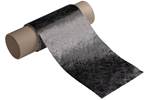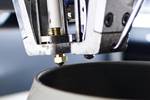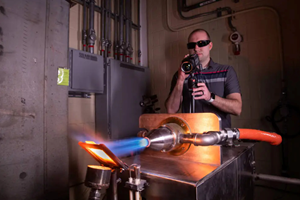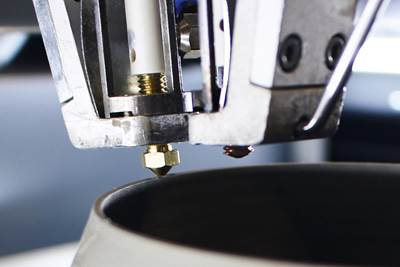New CMC turbine vanes successfully tested in wind tunnel
SiC/SiC ceramic matrix composite (CMC) inlet guide vanes for a high-pressure turbine are aimed for a geared turbofan and show promise for more efficient aeroengines with less weight and need for cooling.
DLR researchers prepare samples CMC turbine vanes for wind tunnel testing at TRL 4 to evaluate their cooling efficiency and aerodynamic performance for future aeroengines. Source | DLR
The 3DCeraTurb project research team — comprising multiple institutes within the German Aerospace Center (DLR, Cologne) — is exploring how ceramic matrix composites (CMC) can be used to manufacture high-pressure turbine vanes for aeroengines. The goal is to reduce weight as well as the need for cooling air/expensive coolant, resulting in reduced emissions toward achieving net-zero aviation. These new CMC inlet guide vanes were developed, manufactured, coated with environmental barrier coating (EBC) and tested by an interdisciplinary team.
A new turbine vane was designed based on the engine boundary conditions of a preliminary UHBR-GTF engine design. The complex blade geometry presents a significant manufacturing challenge, particularly for CMC materials. Source | DLR (CC BY-NC-ND 3.0)
Three SiC/SiC turbine vanes were recently manufactured at the DLR Institute of Structures and Design department of Ceramic Composites and Structures. During the 3DCeraTurb project, DLR’s liquid silicon infiltration (LSI) manufacturing process was adapted from flat plates to a more complex geometry for the first time. A particular challenge was the draping of dry fabric layers into a graphite mold to apply a chemical vapor infiltration (CVI) fiber coating. Another highlight was the demonstration that cylindrical cooling holes could be integrated into the trailing edge of the CMC vanes without damaging the material.
Wind tunnel tests were then performed at the DLR Institute of Propulsion Technology in Göttingen. The new heat-resistant inlet guide vanes, made of SiC/SiC CMC, are aimed for a geared turbofan engine. The lower density of fiber-reinforced ceramics makes it possible to reduce the weight of these components, and thus the overall engine, resulting in an improved thrust-to-weight ratio. Also, due to CMC’s high-temperature resistance, no coolant is required, yet the turbine vanes can withstand up to 1315°C.
3DCeraTurb project
DLR’s 3DCeraTurb project (2021-2024) focuses on the design and manufacture of a turbine vane using SiC/SiC CMC with the goal to establish a process chain for CMC component design, fabrication, EBC coating, wind tunnel validation and damage assessment.
Inlet guide vane for high-pressure turbine. A new turbine profile was designed based on the engine-side boundary conditions of the existing UHBR-GTF engine preliminary design from the DLR Perfect project. The complex vane geometry is a major challenge for the manufacturing process. The up-scaling of CMC manufacturing know-how from flat specimens to a 3D component is key to improving the usability of these materials which offer higher temperature resistance in the hot gas path.
The Straight Cascade Wind Tunnel at the DLR Institute of Propulsion Technology in Göttingen, Germany. Source | DLR
Improved CMC lifetime prediction. Manufacturing process information and data will be integrated into a multiscale simulation to account for manufacturing influences and improve the overall modeling and life prediction of CMC parts. In addition to the material’s microstructure, lifetime limiting damage initiation and damage evolution can also be taken into account consistently over the entire operation period using a phase field approach. Traceability and consistency of the data generated by the project will be ensured by a provenance data system, which is the first component of an automated process chain covering various aspects and details of aerodynamics, structural mechanics and manufacturability.
Wind tunnel testing. In order to analyze and evaluate the aerodynamic performance, these CMC vanes have been tested in the straight cascade wind tunnel at the DLR Institute of Propulsion Technology in Göttingen at TRL 4.
Related Content
Lockheed Martin expands development, production of ultra-high temp CMCs with facility expansion
Targeting current and future needs in hypersonic and aeronautics applications, Lockheed Martin Skunk Works’ Allcomp team is increasing and digitizing its capabilities in ceramic matrix composite (CMC) materials and parts fabrication.
Read MoreGE Aerospace awarded demonstration contract for NASA HyTEC project
Turbofan engine small core technology development with CMC-coated components targets enhanced fuel efficiency in single-aisle aircraft by mid-2030s.
Read MoreDITF Denkendorf advances sustainable carbon fibers, oxide fibers for CMC and more
The German Institutes of Textile and Fiber Research are targeting more sustainable carbon fiber via low-pressure stabilization and bio-based precursors, and working with Saint-Gobain to commercialize oxide ceramic fibers for CMC.
Read MoreRATH prepares for production of advanced oxide ceramic fiber for CMC
New facility in Germany is part of regional supply chain and vision to lead green energy transition using CMC, supported by German government and Composites United’s Ceramic Composites network.
Read MoreRead Next
Safran, Onera begin wind tunnel trials for CFM RISE fan demonstrator
Disruptive Open Fan aerodynamics and acoustics to be matured over 2024-2028 test plan for design validation of fan blades, aiming for implementation on commercial jet engines by 2030s.
Read MoreEngine vane demonstrates potential for gapped, unidirectional dry fiber for infusion
GKN Aerospace and its partners developed an aircraft demonstrator component made with TeXtreme’s latest Gapped UD material, proving out a dry, infusible tape meant to compare in performance to UD prepreg.
Read MoreA new era for ceramic matrix composites
CMC is expanding, with new fiber production in Europe, faster processes and higher temperature materials enabling applications for industry, hypersonics and New Space.
Read More























.jpg;maxWidth=300;quality=90)







